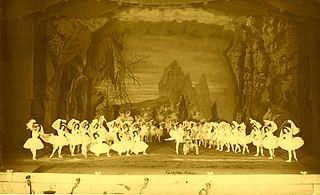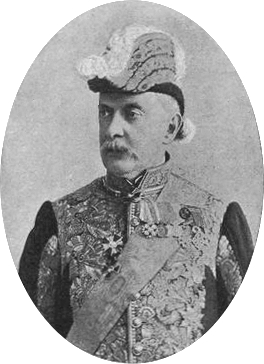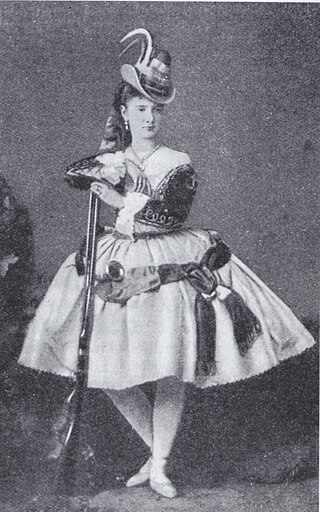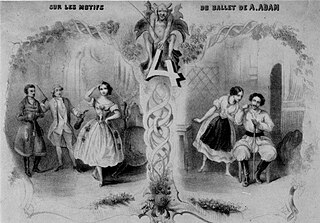Related Research Articles

Pierina Legnani was an Italian ballerina considered one of the greatest ballerinas of all time.

Marius Ivanovich Petipa, born Victor Marius Alphonse Petipa, was a French and Russian ballet dancer, pedagogue and choreographer. Petipa is one of the most influential ballet masters and choreographers in ballet history.

La Bayadère is a ballet, originally staged in four acts and seven tableaux by the French choreographer Marius Petipa to music by Ludwig Minkus and libretto by Sergei Khudekov. The ballet was staged for the benefit performance of the Russian Prima ballerina Ekaterina Vazem, who created the principal role of Nikiya. La Bayadère was first presented by the Imperial Ballet at the Imperial Bolshoi Kamenny Theatre in St. Petersburg, Russia, on 4 February [O.S. 23 January] 1877. From the first performance the ballet was hailed by contemporary critics and audiences as one of the choreographer Petipa's masterpieces, particularly the scene of act II The Kingdom of the Shades, which is one of the most celebrated pieces in all of classical ballet.

Ivan Alexandrovich Vsevolozhsky was the Director of the Imperial Theatres in Russia from 1881 to 1898 and director of the Hermitage from 1899 to his death in 1909.
Paquita is a ballet in two acts and three scenes originally choreographed by Joseph Mazilier to music by Édouard Deldevez and Ludwig Minkus. Paul Foucher received royalties as librettist.
Camargo is a grand ballet in three acts and nine scenes, with choreography by Marius Petipa and music by Ludwig Minkus. The libretto by Jules-Henri Vernoy de Saint-Georges and Marius Petipa is based on an incident in the life of the 18th-century dancer Marie Camargo, in which she and her sister Madeleine were abducted by the Comte de Melun in May 1728 and taken to his mansion.

Arthur Saint-Léon was the Maître de Ballet of St. Petersburg Imperial Ballet from 1859 until 1869 and is famous for creating the choreography of the ballet Coppélia.
Frizak the Barber is a comic ballet in one act, with choreography by Marius Petipa and music adapted by Ludwig Minkus from themes derived from Italian opera.

The Bandits is a grand ballet in two acts and five scenes with prologue, choreographed by Marius Petipa to music by Léon Minkus. The libretto by Marius Petipa is based on Miguel de Cervantes' novella La gitanilla.
The Daughter of the Snows is a ballet in three acts and five scenes, with choreography by Marius Petipa and music by Ludwig Minkus. The libretto by Marius Petipa is based on the 1873 play The Snow Maiden by Alexander Ostrovsky, inspired by a Russian folk fairy tale about Snegurochka from the folklore collection by Alexander Afanasyev.
Zoraiya, the Moorish Girl in Spain is a grand ballet in 4 acts/7 scenes, with choreography by Marius Petipa and music by Ludwig Minkus.

The Magic Pills is a ballet-féerie with three acts and thirteen scenes. The choreography is by Marius Petipa, and the music is by Ludwig Minkus.

Kalkabrino is a ballet in three acts and three scenes, with choreography by Marius Petipa and music by Ludwig Minkus. The story was written by Modest Ilyich Tchaikovsky.
Lydia, the Swiss Milkmaid is a Demi-Caractère ballet in 2 acts, with choreography by Filippo Taglioni and music by Adalbert Gyrowetz.
Mlada is a ballet in 4 Acts/9 Scenes, with choreography by Marius Petipa, and music by Ludwig Minkus.
Pâquerette is a ballet in three acts, with choreography by Arthur Saint-Léon and music by François Benoist.

Le Diable à quatre is a ballet in two acts and three scenes, with choreography by Joseph Mazilier, music by Adolphe Adam, and libretto by Adolphe de Leuven, first presented by the Ballet of the Académie Royale de Musique on 11 August 1845, with Carlotta Grisi and Lucien Petipa.

Ludwig Minkus, also known as Léon Fyodorovich Minkus, was an Austrian composer of ballet music, a violinist and teacher of music.
Les Aventures de Pélée is a ballet in three acts and five scenes with choreography by Marius Petipa and music by Ludwig Minkus, with additional music adapted from works by Léo Delibes. The libretto by Marius Petipa is derived from the Greek Myth concerning the Goddess Thetis and the circumstances surrounding her marriage, arranged by Jupiter, to the mortal Peleus.

Evgenia Pavlovna Sokolova was a Russian dancer and educator. She was one of the most famous ballerinas of her period and later became a famous ballet teacher.
References
- ↑ Meisner, Nadine (2019-06-03). Marius Petipa: The Emperor's Ballet Master. Oxford University Press. p. 181. ISBN 978-0-19-065929-5.
- ↑ Anderson, Zoë (2015-01-01). The Ballet Lover's Companion. Yale University Press. p. 35. ISBN 978-0-300-15428-3.
- ↑ Garafola, Lynn (1989). Diaghilev's Ballets Russes. Oxford University Press. p. 13. ISBN 978-0-19-505701-0.